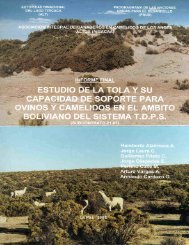evaluación de humedales (2.66 mb)
evaluación de humedales (2.66 mb)
evaluación de humedales (2.66 mb)
Create successful ePaper yourself
Turn your PDF publications into a flip-book with our unique Google optimized e-Paper software.
Evaluación y caracterización <strong>de</strong> bofedales<br />
El cuadro B-10 <strong>de</strong>l anexo y figura 4.82, muestra la composición y porcentaje <strong>de</strong> las<br />
especies y material inerte para el pastoreo, la gran diversidad existente en los bofedales <strong>de</strong><br />
la provincia el Collao, por la misma razón que cuenta con bofedales <strong>de</strong> variada extensión,<br />
que están distribuidos ampliamente en toda la escala altitudinal, afectados por diferentes<br />
parámetros a<strong>mb</strong>ientales y climáticos, que influyen las características estructurales <strong>de</strong> la<br />
vegetación.<br />
La variabilidad florística, es un factor fundamental en el balance <strong>de</strong> la alimentación animal<br />
al pastoreo, concordando esto con las evaluaciones realizadas por Vargas (1992) en puna<br />
seca <strong>de</strong> Puno, que reportan a Hypochoeris stenocephala, Alchemilla diplophylla, Lilaeopsis<br />
andina, Lilaea sabulata. Siendo Distichia sp. (29.56%), la más predominante, igualmente<br />
estudios en zonas similares muestran que Distichia sp. es <strong>de</strong> importancia con (30.89%),<br />
seguidos <strong>de</strong> Eleocharis albibracteata (10.88%), Calamagrostis rigescens (10.26%), datos<br />
que corroboran nuestros resultados.<br />
0.74<br />
0.83<br />
0.15<br />
1.16<br />
7.11<br />
0.22<br />
4.15<br />
0.76<br />
0.16<br />
0.09<br />
3.10<br />
5.26<br />
0.15<br />
1.27<br />
0.57<br />
0.20<br />
0.23<br />
0.53<br />
0.43<br />
5.25<br />
0.40<br />
Facultad <strong>de</strong> Ciencias Biológicas U.N.A. Puno.<br />
0.33<br />
2.94<br />
0.00<br />
2.48<br />
8.47<br />
2.12<br />
0.86<br />
5.67<br />
0.23<br />
0.16<br />
0.37<br />
0.37<br />
Acac Aldi Alpi Casp. Capu Decu Deem Deov Deri Devi Difi Dimu<br />
Disp. Elal Fedo Gepo Gese Geses Hyer Hyta Hyre Jumi Lian Luco<br />
Luku Lyac Müli Müpe Myqu Mycfpa Oumu Oxan Plmo Pltu Posp. Pofi<br />
Rabr Rafl Rapr Sc<strong>de</strong> Scri Scsp. Vipy Weap Wepy Mu y Lí Pie ro SueDe<br />
Figura 4.82: Cobertura y Composición Florística (%), en bofedales <strong>de</strong> la Provincia<br />
<strong>de</strong> El Collao, Puno – 2000.<br />
A continuación se presenta los bofedales y su principal característica <strong>de</strong> cobertura vegetal:<br />
Bofedal Quenan hoyo: Ubicado en el distrito <strong>de</strong> Ilave a 3900 msnm; con una cobertura<br />
vegetal total <strong>de</strong> 96.40%, y el 3.60% pertenecen a musgos, líquenes y suelo <strong>de</strong>snudo. Don<strong>de</strong><br />
Hypochoeris taraxacoi<strong>de</strong>s (18.00%) y Scirpus sp. (15.60%), constituyen mayor<br />
dominancia, mientras Ranunculus flagelliformis, Alchemilla pinnata (1.50%) cada una y<br />
Alchemilla diplophylla (0.50%), representan en menor porcentaje.<br />
0.37<br />
0.77<br />
3.81<br />
0.90<br />
0.06<br />
0.48<br />
0.28<br />
5.04<br />
0.09<br />
8.55<br />
3.46<br />
0.57<br />
2.13<br />
13.29<br />
3.43<br />
196




